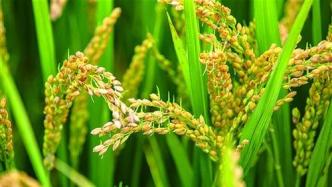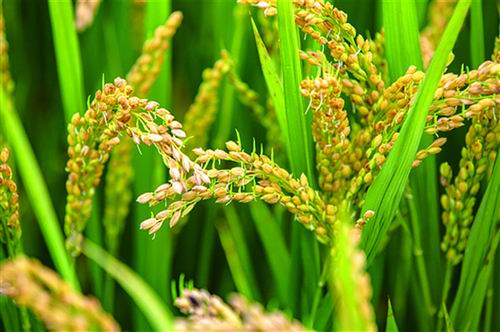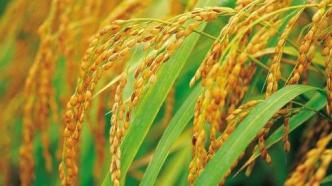

Spike germination threatens rice yield. Wang Dehao/photo
Many grains have not been harvested in the fields, and the seeds on the spikes are covered with small green seedlings.
"The quality of germinated seeds is reduced, which seriously affects food production. Some over-germinated seeds cannot even be processed for feed, which greatly reduces farmers' income." Chu Chengcai, a researcher at the Institute of Genetics and Developmental Biology, Chinese Academy of Sciences (hereinafter referred to as the Institute of Genetic Development), said. "Chinese Journal of Science" said.
Now, Chu Chengcai's team and the researcher Gao Caixia's team at the institute have found a pair of "switches" that regulate the germination of rice and wheat ears, which is expected to provide a solution to the large-scale agricultural losses caused by seed ear germination. The results were published online in Nature Genetics on December 5.
"Relevant research results are exemplary work of using germplasm resources to mine beneficial genes and quickly apply them to breeding innovation at home and abroad in recent years, providing a reference for the effective use of ancient local germplasm resources." Academician of the Chinese Academy of Sciences, Crop Science of the Chinese Academy of Agricultural Sciences Qian Qian, director of the institute, commented.
"Mr. Sprout" looking for "switch"
In the Institute of Genetic Development, Chu Chengcai had a nickname - "Mr. Spike Germination".
Twenty years ago, by chance, Fang Jun, a student of Chu Chengcai, went to Qianqian to look at the rice materials in the experimental field in Hangzhou. He found that after several days of continuous rain, some of the rice materials had not been confiscated, but the seeds had germinated on the ears. Fang Jun took a photo of Chu Chengcai, which aroused Chu Chengcai's desire to study ear germination.
In order to speed up the generation process and ensure that the seeds have consistent germination characteristics in production, breeders will eliminate some dormant materials during the breeding process. In recent years, the phenomenon of seed germination has become more and more serious.
The global economic losses caused by ear germination are incalculable. According to statistics, the annual loss of bread wheat alone is as high as 1 billion US dollars. The Grain Ear Germination Committee has been specially established internationally, and an international conference is held every three years to discuss solutions. However, the problem of ear germination has not been fundamentally contained.
In southern China rice cultivation areas, affected by the rainy season during the harvest season, panicle germination will cause a loss of 6% of the cultivated area of conventional rice, while the loss of hybrid rice can be as high as 20% of the cultivated area. "Because gibberellin is sprayed during the seed production process of hybrid rice, the phenomenon of seed germination will be more serious." Yang Yuanzhu, vice president of Longping Hi-Tech and chief rice expert, said.
Zhang Conghe, deputy general manager and chief technology officer of Quanyin High-Tech, also said that in the areas along the Huaihe River and south of the Huaihe River in my country, frequent occurrence of bad weather such as rain or high temperature and drought has caused a decrease in seed yield, and frequent rainy weather has caused severe panicle germination, resulting in Seed quality is substandard. Food safety production urgently needs to solve the ear germination problem of wheat and rice varieties.
The breeder told Chu Chengcai who often dealt with it: "It is too difficult to find an expert who studies panicle germination."
This strengthened Chu Chengcai's determination to find the gene "switch" related to seed dormancy. "Seed dormancy is the phenomenon that seeds cannot germinate under conditions suitable for growth such as temperature, water and oxygen. This is a characteristic shared by most higher plants." Chu Chengcai explained to the Chinese Journal of Science.
In fact, scientists have considered screening germplasm resources of strong dormancy from wild rice, weedy rice, and ancient landraces since the 1950s. However, because this agronomic trait is regulated by a large number of loci, gene cloning faces many bottlenecks. The key gene resources used to improve panicle germination in production are still very scarce.
After nearly 10 years of hard work, Chu Chengcai's team finally found a key gene that controls rice seed dormancy in the strong dormancy native Indian rice variety "Kasaras", providing a "sharp tool" for regulating grain ear germination.
"Gas" and "Brake"
Using the strong dormancy variety "Casaras" and the weak dormancy variety "Nipponbare", Dr. Xu Fan, Tang Jiuyou, Cheng Xi and other doctors in Chu Chengcai's team successfully cloned from "Casaras" by constructing a chromosome single-segment substitution line To a key gene SD6 controlling rice seed dormancy, and confirmed that SD6 negatively regulates rice seed dormancy. By screening SD6 interacting proteins, the research team also found another rice transcription factor, ICE2, which positively regulates seed dormancy.
"In simple terms, they are like two partners that check and balance each other. SD6 is like a 'gas pedal' that can promote seed germination; while ICE2 is like a 'brake' that can promote dormancy." Chu Chengcai said.
So how does the molecular building block of these two partners work? Studies have shown that the plant hormone abscisic acid (ABA) is the main internal factor regulating plant dormancy germination. Further research found that the SD6/ICE2 molecular module can regulate the ABA content and seed dormancy of rice seeds by directly or indirectly regulating ABA synthesis or metabolism genes.
"This discovery reveals how crops achieve real-time balance through synergistic hormone synthesis and metabolism, thereby regulating the internal mechanism of important agronomic traits." Qian Qian commented.
Interestingly, the researchers found that the SD6/ICE2 molecular module has also evolved a very "smart" environmental adaptation mechanism: SD6 maintains high expression at higher temperatures, while ICE2 maintains low-level expression, which is conducive to the development of seeds at higher temperatures. Break dormancy for germination; when encountering low temperature, the expression of SD6 is inhibited, and the expression of ICE2 is significantly up-regulated, which is beneficial for the seeds to maintain a dormant state to avoid low temperature adversity and survive the winter smoothly.
"By sensing changes in the temperature of the external environment, SD6/ICE2 ebb and flow, and further control the ABA content in the seeds, thereby regulating the dormancy intensity of the seeds, ensuring that they adapt to the natural seasons and reproduce successfully." Chu Chengcai explained.
The research team improved the SD6 gene in the easy-ear germinating rice varieties "Tianlong 619", "Wuyunjing 27" and "Huaidao 5" through gene editing technology, and found that the improved rice materials encountered continuous rainy weather during the harvest period. In this case, ear germination was significantly improved.
“So useful”
Not only rice, Gao Caixia's team improved the TaSD6 gene of the wheat variety "Kenong 199" and found that the resistance of wheat ear germination was greatly improved. This indicates that the function of SD6 gene in controlling seed dormancy in rice and wheat is conserved, and it has potential value in breeding and improvement of ear germination resistance in other cereals.
"This study excavated SD6, a quantitative trait locus controlling seed dormancy, from an Indian landrace with strong dormancy, which proves that not only can rice panicle germination be improved through traditional breeding, but also gene editing technology can be used to quickly create panicle germination-resistant Rice and wheat germplasm materials." Qian Qian said that this is a "model" for scientists at home and abroad to use germplasm resources to mine favorable genes and quickly apply them to breeding innovation in recent years.
"It's so useful!" Several breeders said to Chu Chengcai after reading about this progress.
"This research will significantly improve rice panicle germination resistance in the field environment, and has no adverse effects on other important agronomic traits, which brings hope for us to breed panicle germination-resistant hybrid rice male sterile lines and their varieties." Yang Yuanzhu said.
Zhang Conghe also said that this achievement is of great significance, solving the "stuck neck" problem in the global seed industry and grain production, which will play a very good role in promoting international food security and food quality, and will also promote the development of the wheat and rice seed industries. Safe and high-quality production will further enhance the core competitiveness of my country's seed industry enterprises.
Talking about the next step, Chu Chengcai, the "Mr. Ear Germination", looks forward to further verification of related genes in other grains such as corn, barley, and sorghum.
Related paper information:
https://doi.org/10.1038/s41588-022-01240-7
(Original title "Seed dormancy "switch" found to significantly improve the germination of rice and wheat ears")

